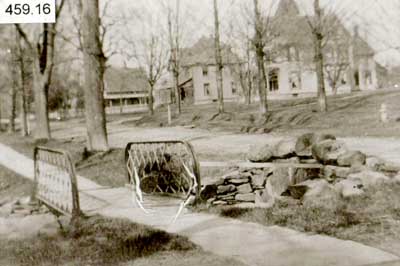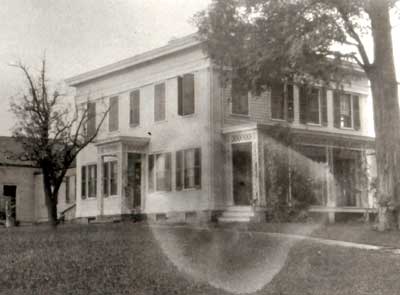2012/2013 GCS After School Enrichment: Local History -- North Street


view from upper school driveway, looking north on Rt 32
Rundell house, on school site, before moving across street
|
2012/2013 GCS After School Enrichment: Local History -- North Street |
|
|
|
|
|
view from upper school driveway, looking north on Rt 32 |
Rundell house, on school site, before moving across street |
Although Greenville never changes, the accumulation of alterations has created a different Greenville than our “oldtimers” can recollect from their young days. Our walk south from the park is reminder.
Immediately north of the park, when standing at the park’s entrance, one sees a string of attached motel units, now apartments. Missing is the central building, the former Jesse house. Once a farm house, Jesse’s Elm Shade drew guests in the early and mid-century until it was razed in the 1980s. This historical marker notes Benjamin Spees as one of the town earliest founders (along with Lake and Knowles).
From the park’s entrance, one’s eyes note the barns. These barns were the accompaniments to the Sherrill/Vanderbilt house that operated as a prosperous farm until the 1970s. Shown below is a post card photo of the house from the early, which stood until it was razed, along with the nearby outbuildings, only a few years ago. The park’s 156 acres were the agricultural fields of this farm.
The properties across the street, up to Irving Road, are relative newcomers to Greenville.
The yellow house below the park entrance, built in 1978, occupies the site of the tennis court of Lewis Sherrill and the Knowlton (next).
Next,
on the same side, sits the
classic white clapboard farm house this
side of
the Westerner is locally known as the Knowlton, named after the Knowles family
who owned
it.
Charles
Knowles was an influential, prosperous landowner in the 1870s and 1880s who kept
his “summer house” as he lived in Albany.
The
buildings across the street are 20th century “newcomers.”
The
Westerner is a relative youngster, and the two houses forming the Westerner
square are Irving properties. The Irving residence is considered by some to be
the oldest house in town.
The
Baumann house is one of the town’s oldest houses. The
historical marker notes it as the Talmadge & Atwater house.
Below
the Baumann house is a newer, colonial
white house with green shutters was built about 1940.
It was lived in for many years by the O’Keefe family.
Back
to this side of the street is the Stanger house, next to the Irving houses. It
is another of Greenville’s older houses, dating to mid-19th century.
South
of us, from Westerner to the creek (and school driveway) is a string of house
left mostly unchanged over the past one hundred years.
Across
the street, the brown-shingled, end gables facing the road was the residence of
the Clark family while Richard Clark served as the Episcopal minister during the
1960s and 1970s.
Next
to that was the Manse, serving Reverend Van Dyke in the early 20th century.
Next,
the
“Powell” house (left, two houses before creek), was a stately residence that
had a three story tower.
“Doc” Wasson lived here.
The
last house before the creek across the school is a classic Victorian rural
building known locally as the Vaughn building, which became divided into
apartments.
We
cross the bridge over a small creek which originates in the fields uptown (in
the Bryant’s and “Balsam Shade” area), large enough to cross Rt 32 just
above the resort by the driveway to the park and winding its way through the
park before crossing Rt 32 again here.
We
cross the bridge, and dominating the view from here is the Scott M. Ellis
Elementary School.
Population
increases dictated additions and use of community structures as classroom space
until the high school was built in 198-69. The school district celebrates its
75th anniversary in 2007.
Across
the street sits the
salmon colored house.
It
was moved
there
over a two day period, partially straddling the main road overnight, to make way
for the new school building. It has been in the Rundell family for nearly 90
years.
Next
to the Rundell house is the parsonage, originally a residence.
Next
is the
Episcopal Church.
The stone to build it came from the Sanford farm from Route 26 (also known as
the George Turon farm).
Just
below the church is an empty spot before the cemetery driveway stood a residence,
owned by Sylvester Story. Then the driveway leads back to the cemetery.
Backing
up just a little, on the right side, is the
small Boy Scouts building.
It
served as the
chapel for the Presbyterian Church and was recently used as the American Legion
building. It also was used as an emergency school room during the 1960s.
Next
is The
All Arts Matter – Cultural Center building.
It looks
like a church because it was Greenville’s Presbyterian Church from the 1790s
until the
1990s.
AAM is currently the town’s leading cultural influence.
The
library
building was built in 1906, with an addition in the 1990s. Originally, the
Greenville Free Academy occupied the site since 1816 before it was razed in
1905. With the centralization of schools, the building has mostly been used as a
public library, with other uses in its history.
It
should be noted that the area from the pond to the school was donated to the
town by Augustine Prevost two hundred years ago and, today, has Historic
National Register status.
The
realty office
was Flach’s barbershop until recently, having been built for that purpose in
1963.
It stands on the site of a blacksmith shop.
The
fire house
in back
is of block construction (mostly), built in the early 1940s and used as a farm
machinery building.
The
creek mentioned earlier crosses Rt 32 again (and not for the last time, either).
The bridge was recently replaced.
The
hot dog stand has been a fixture since the 1960s, its first incarnation was
Matt’s Hot Dogs.
The
now abandoned gas station was a gas station since the 1940s. Before that is was
a centerpiece residence, with a white picket fence, that distinguished the
town’s center.
The
pond has been a pond longer than anyone can remember, with alterations to its
banking, fountain, and outlet into the creek. The gazebo was built in 1989 was a
thank you gesture from the GCS band for fundraising efforts for a trip.
The
four corners is the crossing of the state roads, 81 and 32, with the east-west
road being Greenville’s main street, indicating the direction that the early
turnpikes crossed the town two hundred years ago.
Across
Rt 81 sits the Pioneer Building, today’s Greenville Town Hall, a topic for
another tour.